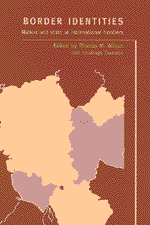Book contents
- Frontmatter
- Contents
- List of maps
- List of contributors
- Acknowledgements
- 1 Nation, state and identity at international borders
- 2 State formation and national identity in the Catalan borderlands during the eighteenth and nineteenth centuries
- 3 A western perspective on an eastern interpretation of where north meets south: Pyrenean borderland cultures
- 4 The ‘new immigration’ and the transformation of the European-African frontier
- 5 Transnationalism in California and Mexico at the end of empire
- 6 National identity on the frontier: Palestinians in the Israeli education system
- 7 Grenzregime (border regime): the Wall and its aftermath
- 8 Transcending the state? gender and borderline constructions of citizenship in Zimbabwe
- 9 Borders, boundaries, tradition and state on the Malaysian periphery
- 10 Markets, morality and modernity in north-east Turkey
- 11 Imagining ‘the South’: hybridity, heterotopias and Arabesk on the Turkish–Syrian border
- Author index
- Subject index
3 - A western perspective on an eastern interpretation of where north meets south: Pyrenean borderland cultures
Published online by Cambridge University Press: 02 December 2009
- Frontmatter
- Contents
- List of maps
- List of contributors
- Acknowledgements
- 1 Nation, state and identity at international borders
- 2 State formation and national identity in the Catalan borderlands during the eighteenth and nineteenth centuries
- 3 A western perspective on an eastern interpretation of where north meets south: Pyrenean borderland cultures
- 4 The ‘new immigration’ and the transformation of the European-African frontier
- 5 Transnationalism in California and Mexico at the end of empire
- 6 National identity on the frontier: Palestinians in the Israeli education system
- 7 Grenzregime (border regime): the Wall and its aftermath
- 8 Transcending the state? gender and borderline constructions of citizenship in Zimbabwe
- 9 Borders, boundaries, tradition and state on the Malaysian periphery
- 10 Markets, morality and modernity in north-east Turkey
- 11 Imagining ‘the South’: hybridity, heterotopias and Arabesk on the Turkish–Syrian border
- Author index
- Subject index
Summary
In Boundaries: the making of France and Spain in the Pyrenees Peter Sahlins argues that French and Spanish national awareness evolved as an autochthonous process within the borderland area itself, rather than as an imposition from the outside (Sahlins 1989). He bases his conclusion upon historical developments in the Cerdanya Valley of the eastern Pyrenees.
The work has fascinating, counter-intuitive implications for historians and political scientists, since their usual assumption is that international borders crystallise where the limits of the hegemony of two political epicentres (in this case Paris and Madrid) meet and become stalemated. Establishment of the border is therefore a reciprocal measure for consolidating and delineating the defence of their respective national sovereignties. In this view the border is truly the proverbial ‘line in the sand’, with the implication that the inhabitants of the borderlands are more or less passive and incidental agents of wider national purposes. Sahlins's argument that the inhabitants of the Cerdanya, although ethnically Catalan, precociously infused local disputes and competition for scarce resources with French versus Spanish connotations, well before the full maturing of the national distinctions between the two emerging nation-states, is therefore quite radical. At a stroke it turns the borderlanders into the architects of their own destiny, as well as catalysts in the nation-building process of both France and Spain.
- Type
- Chapter
- Information
- Border IdentitiesNation and State at International Frontiers, pp. 62 - 95Publisher: Cambridge University PressPrint publication year: 1998
- 12
- Cited by



